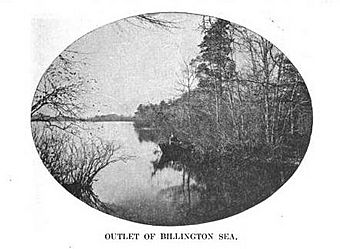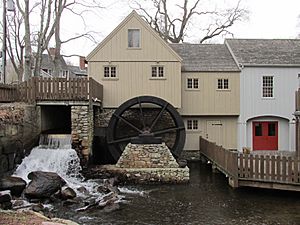Town Brook Historic and Archeological District facts for kids
Quick facts for kids |
|
|
Town Brook Historic and Archeological District
|
|

Town Brook flows from Billington Sea
|
|
| Location | Plymouth, Massachusetts |
|---|---|
| Built | 1633 |
| Architect | Kitson, Henry H. |
| Architectural style | Mid 19th Century Revival, Georgian, Colonial |
| NRHP reference No. | 95001176 |
| Added to NRHP | October 12, 1995 |
The Town Brook Historic and Archeological District is a special area in Plymouth, Massachusetts. It covers most of the Town Brook and the land around it. This place has a long history, going back to 1620. That's when the Pilgrims arrived on the Mayflower and started Plymouth Colony. The district stretches from Billington Street to where the brook meets Plymouth Harbor. It was added to the National Register of Historic Places in 1995.
Contents
Exploring Town Brook's History
This historic district holds many old buildings and hidden remains from over 300 years ago. You can find four old mill ponds, dams, and special paths for fish called herring runs. There are also places where mills used to be, showing how people used the brook's water power.
Old Homes and Buildings
The district also has many different types of houses from various time periods. The oldest house still standing in Plymouth is here. It's called the Richard Sparrow House, and it was built way back in 1640.
The Power of the Brook: Mills and Industry

Early settlers built mills along Town Brook to help them live. These mills used the water to saw wood and grind grain into flour. As Plymouth grew, smaller businesses also used the brook's power for other tasks.
Mills Through the Centuries
In the 1800s, bigger factories came to Town Brook. They used the water power for more industrial work. Around the early 1900s, some mills that processed iron were built. Some of these old buildings are still standing today. Many 19th-century industrial buildings were lost over time, often due to fires.
Parks and Reconstructions
In the early 1900s, people became very interested in the area's rich history. This led to the creation of Brewster Gardens in the 1920s. It's a public park located near where the brook flows into the harbor. Close to the park, you can see the Jenney Grist Mill. This mill was rebuilt in 1970, looking like an early grist mill that burned down in 1837.



